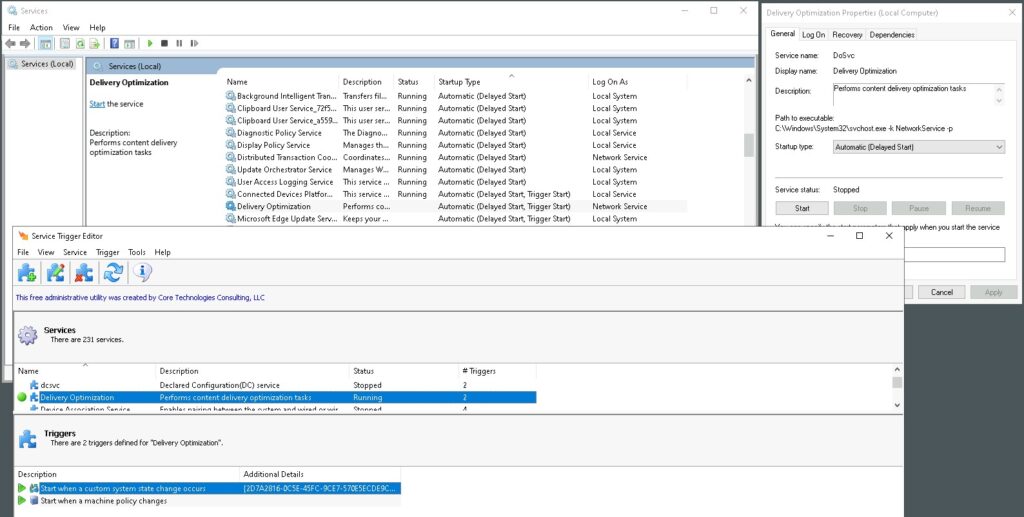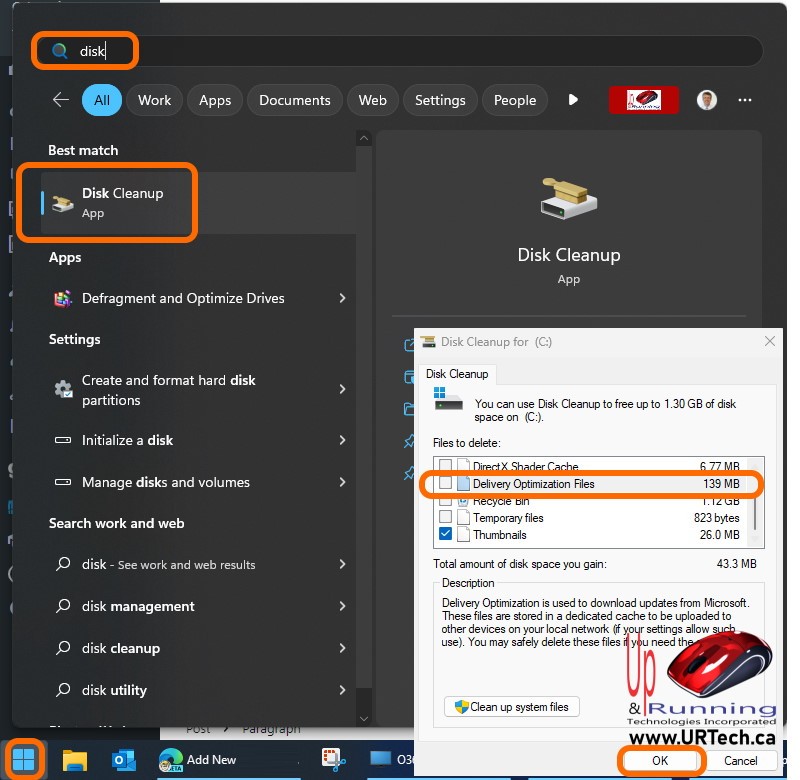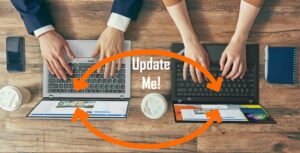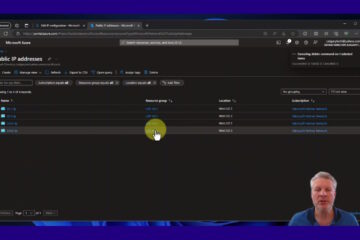In this short article we are going to explain several things that all tech’s need to understand both the Delivery Optimization service in Windows.
1 – What is the Windows Delivery Optimization Service (WUDO)?
The Windows Delivery Optimization Service (aka WUDO) let’s your computer pull parts of updates from computers on your home / work network and sometimes from other computers on the Internet that are not Microsoft servers. It also allows your computer to give parts of updates to other computers on your network and sometimes to other computers on the Internet.
WUDO both saves Microsoft a vast amount of data transfer from its servers and also drastically speeds up the rate at which you can download patches.
2 – What Can the Delivery Optimization Service Update?
The Delivery Optimization Service only works with files from Windows Update and the Microsoft Store. It has no bearing on other programs. For instance, the Delivery Optimization Service will do nothing to assist (or hinder) updating Adobe Photoshop.
3 – How Can I See If the Delivery Optimization Service is Actually Doing Anything Useful?
Windows has a nice gui that shows you how effective the delivery optimization service is on your computer:
- Start > Settings > Windows Update > Advanced options
- Select Delivery Optimization
- Select Activity Monitor
You can see that in my case it’s not doing anything but that’s because on the computer I’m working on at this moment

4 – Can The Delivery Optimization Service Be Turned Off?
Yes, the delivery optimization service can be turned off without any problem however the computers on your network will then all be forced to pull their updates directly from Microsoft and that will result in:
- increased Internet traffic
- decreased local area network traffic
5 – How To Configure The Windows Optimization Service?
There are several ways to configure the Windows Optimization Service including just going into services and setting the services to disabled. However the more appropriate way to do it is using the graphical user interface:
- Start > Settings > Windows Update > Advanced options
- Select Delivery Optimization
- In Allow downloads from other PCs,
- select ON or OFF (slider on the right)
- Devices on my local network or Devices on the internet and my local network
6 – Is Delivery Optimization Service Only For Companies?
The Delivery Optimization Service has its greatest impact inside companies but it is still highly useful on home computers.
7 – Does The Delivery Optimization Service Send Personal Files or Data?
No, the Delivery Optimization Service does not send ANY personal data.
“Delivery Optimization can’t be used to download or send personal content. Delivery Optimization doesn’t access your personal files or folders, and it doesn’t change any files on your PC.”
Windows Update Delivery Optimization and privacy – Microsoft Support
8 – Is Windows Delivery Optimization Service Safe?
Files transferred between computers using Delivery Optimization Service, rather than coming directly from Microsoft, Are verified as being unmodified so you can trust that they are safe.
9 – When Did Delivery Optimization Service Get Added To Windows?
The Delivery Optimization Service was added to Windows 10 and Windows Server 2016 and exists in all versions of Windows sense.
10 – Should the Delivery Optimization Service Always Be Running?
No, the Delivery Optimization Service starts and stops automatically as needed.
11 – Why is the Delivery Optimization Service Set to DELAYED START – TRIGGERED START?
The Delivery Optimization Service Starts up after your computer has been running for a few minutes so it’s not to slow down your login. The service does not need to be running the second the computer has started and does not need to be running / consuming resources all the time.
12 – What Are the Triggers To Start the Delivery Optimization Service?
As you can see in the screenshot below, the Delivery Optimization Service has two triggers:

However, that information is still nebulous so here are some real life examples of when the Delivery Optimization Service with start:
Scheduled Windows Updates:
The Delivery Optimization service may be triggered when Windows Update initiates scheduled updates. It helps to download updates from other devices on the local network or the internet to improve download speed and reduce bandwidth usage.
Store App Updates:
When updates for Microsoft Store apps are available, the Delivery Optimization service can be triggered to optimize the download process. It can obtain the update packages from other devices or content delivery servers.
Peer-to-Peer Sharing:
Delivery Optimization utilizes peer-to-peer sharing, allowing your device to receive Windows updates or app updates from other devices on the same network or the internet. When a device on your network has already downloaded the update package, the Delivery Optimization service may be triggered to obtain the update from that device.
Background Intelligent Transfer Service (BITS):
The Delivery Optimization service works in conjunction with the Background Intelligent Transfer Service (BITS). BITS is responsible for the actual download and transfer of the update packages. The Delivery Optimization service coordinates with BITS to optimize the download process.
It’s important to note that the exact triggers and behavior of the Delivery Optimization service may vary based on the configuration and settings of your Windows computer. Microsoft may (will?) also introduce changes or updates that can affect how the service operates in the future.
13 – Where are Delivery Optimization Files Stored?
Not too surprisingly delivery optimization files are stored in C:\Windows\System32\DeliveryOptimization
14 – How Much Space Do Delivery Optimization Files Consume?
The amount of disk space that the delivery optimization files take varies machine by machine but I have seldom seen it take more than about 1GB of space. Looking at my windows 11 machine right now I see it’s taking 139MB and looking at a clients Windows Server 2019 box I see it’s taking 1.2 GB.
15 – Are Delivery Optimization Service Files Automatically Deleted?
Yes, delivery optimization service files are periodically deleted automatically by the system so there is seldom in need for you to manually interfere.
16 – Can Delivery Optimization Service Update Files Be Removed Manually?
Yes, if you’re low on disk space You can safely delete the delivery optimization files using the disk cleanup wizard that’s built into all current versions of Windows.

While we don’t think it’s an actual crisis, it is said that you should not delete the files manually out of C:\Windows\System32\DeliveryOptimization as they could be in use or being transferred in the background.
17 – Is There A Command Line Tool To Check The Status of The Delivery Optimization Service?
Yes, you can check the status of the delivery optimization service using the PowerShell tool Get-DeliveryOptimizationStatus .
Note that you need to move very quickly with this it will only return information if it is in use.
18 – What Websites Does The Delivery Optimization Service Need Access To?
As of 2023, the delivery optimization service only talks to these four domains, Primarily to validate that the update segments you have received are untouched originals.
*.download.windowsupdate.com
*.windowsupdate.com
*.dl.delivery.mp.microsoft.com
*.emdl.ws.microsoft.com
19 – What Ports Does The Delivery Optimization Service Use To Transfer Files?
When transferring files between computers on the same network the delivery optimization service uses tcp and udp port 7680 but when it is transferring data between computers on the Internet it uses Torado on port 3544.




0 Comments